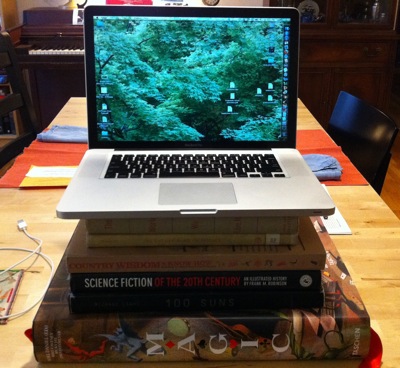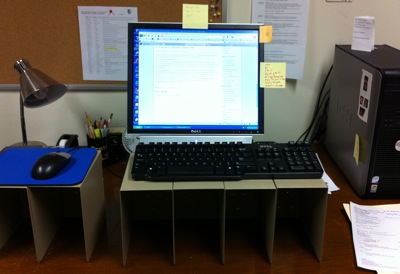February 12th, 2011 · 3 Comments
Last month this blog post on the New York Times website made the rounds of my Twitter stream. Apparently evidence is growing that too much sitting can be harmful to our health, even for those who exercise regularly. I’ve been reading about the benefits of standing desks for a while now, and this was the push I needed to give it a try. Plus, that fat cat was really scary.
I can’t justify buying a whole new desk, so I set to figuring out how to rig a temporary standing desk at home and at work. Home is somewhat easier because my primary computer is a laptop. We have lots of big, big books, and it turned out to be no trouble at all to pile a bunch of books on the dining room table and pop my computer on top. Here’s what it looks like:

But most weekdays I’m in the library, so I wanted to try a standing desk at work, too. Lots of books there, of course, but I can’t just take books from the stacks to pile on my desk. Enter some extra metal journal holders that were sitting on the shelves in my office when I moved in last semester. As it happens, when you place 4 of them next to each other and turn them face down, they make a perfectly sized surface for my computer keyboard. Another two together fit the mousepad and mouse. Then I pull up my computer monitor and tilt it back slightly, and my temp standing desk for the office is all set:

In some ways the work setup is even better than the pile of books at home, because the keyboard is close to the edge of the journal holders which encourages me not to drop my wrists as I type.
Both setups are easy to put up and take down quickly, which is important because one thing I’ve learned over the past couple of weeks is that I’m not ready to move to a standing desk full time. Certain things are more difficult to do while standing, like eating while working or writing in longhand (though the latter would likely be easier on a real rather than temp standing desk).
But I’ve found that I really enjoy having the option to stand or sit while I work. Standing seems to make it easier for me to focus on certain tasks, like sustained work on a project. On the other hand, if I’ve been running around between meetings and teaching and other stuff, it’s nice to sit down for a spell.
Tags: Uncategorized
Perhaps you saw the article in last week’s Chronicle of Higher Ed about the difficulties of searching library catalogs. No? Librarians have been chatting about it all week. I’ve been chewing over it too, and finally have time to get down some comments.
It’s true that many library catalogs and article databases have poorly-designed user interfaces, I absolutely won’t argue with that. And it’s very frustrating, both as a librarian and a user. However, the article seems to muddle a few different issues.
The article begins with the story of a graduate student who’s had trouble finding books on Thomas Jefferson. I have to admit that I’m a bit mystified by a few things:
1. Online library catalogs provide keyword searching, but they also allow searching by title, author, or subject. My guess is that if the student had searched for Jefferson by subject, her search would have been successful. Of course, with the ubiquity of the internet everyone has become more accustomed to keyword searching (including librarians). But, frankly, a keyword search of Thomas Jefferson on the internet also wouldn’t produce the results that this grad student needs (umm, Wikipedia?). As librarians, we need to remind our users that for simple questions, simple internet searches will usually suffice, but more complex information needs will require more complex search strategies.
2. Books in libraries are organized by subject, just as are books in bookstores. Of course librarians assign call numbers to books to catalog and organize them, but the call numbers are arranged by subject; thus library stacks can be browsed in the same way as at bookstores. Maybe we also need to remember to emphasize that to our users. At my library we have neat bookmarks with the Library of Congress call number ranges printed on them that we can pass these out to students at the reference desk — I need to remind myself to do that more often.
3. Article databases can be particularly difficult to use, especially for novice searchers. Database interfaces are complex, and it’s confusing to students that there are so many different interfaces to learn to use. This is a direct result of the economic and production history of scholarly journal publishing, but knowing this doesn’t make the reality of searching article databases any easier. Yes, new products can search across multiple databases and the library catalog at the same time (called federated searching), but they can be clunky to use. And they’re usually expensive, too.
I’m excited about new solutions coming down the pike, but (like some of the commenters on the Chron’s piece) I’m hesitant to believe that one, magical, Google-style search box should be the utopian goal for academic libraries. Scholarly information is complex. It’s text, images, data, audio, video, some “traditionally” published and some not so much, and it’s in all sorts of places on the internet: free, paid, and in-between. It would certainly save us a lot of time if we had a search engine sophisticated enough to find the scholarly info we need amongst all of the billions of pages non-scholarly content on the internet. But isn’t searching an important part of the scholarly process? Doesn’t it help us refine our questions and discover new areas of interest?
Or maybe it’s just that I like searching. Which, I suppose, is why I’m a librarian.
Tags: Uncategorized
My iPhone recently celebrated its first birthday, and I’ve been reflecting on how it’s changed my information and communication habits. Last summer I upgraded from a regular old dumbphone, so I didn’t have any prior experience with Blackberries et al. I should also mention that I am not a heavy phone user–talking on the phone is probably my least favorite way to communicate. I was an AT&T subscriber before getting an iPhone so specifics of the phone service don’t have much of an impact on me, either, though I was pleased to discover that phone calls on the 3G network sound better than on my old phone.
I love my iPhone and will never go back to just any old phone. Here are my top iPhone uses (in reverse order, because it’s more suspenseful):
4. Google Maps
Combined with the phone’s built-in GPS, Google Maps is a powerful tool that I rely on constantly to get around the city and on trips out of town. The first time the iPhone helped us route around the perpetually-heinous traffic on the Staten Island Expressway I nearly wept tears of joy.
3. Music
This one will be more obvious and less interesting when I reveal that I only had a tiny iPod Shuffle before getting my iPhone, so it’s still somewhat novel for me to carry around a device with ca. 6gb of music/podcasts. Using Pandora to create custom streaming radio stations is fun, too.
2. Internet
The entire internet in one small device, what could be better? From checking the weather forecast to finding information to answer questions both frivolous and serious, I use the internet on my phone throughout the day. My 7-yr-old now refuses to wait until we’re home to find the answers he seeks, instead demanding: “look it up on your phone, Mom.”
1. Reading
In retrospect, my biggest surprise is how much time I spend reading on my iPhone. It’s true that much of my reading is internet-related; my daily rounds include Twitter, Google Reader for my RSS feeds, and the New York Times. But what shocks me is how much other reading I do on the iPhone, even reading (gasp!) books. I’d never been able to get into reading an ebook on the computer, but now I realize that’s more about location than technology. I can read on the iPhone anyplace I’d take a physical book. And since I’m one of those people who breaks into a cold sweat at the thought of being stuck somewhere without anything to read, having 37 books in my pocket is an enormous relief. As I’m typing this it occurs to me that having an iPhone has probably increased the amount of reading I do on a daily basis, too.
Just to balance things out, here are the top uses I expected for my iPhone that haven’t been as important as I’d anticipated:
3. Games
I do play games on the phone–obsessions have included Subway and Flight Control–but not as much as I thought I would. I’m an avid gamer and had hoped that the iPhone would let me play more often, since I never can seem to find the time for them lately. I guess the big stumbling block has been my hesitation to buy new games (which probably means that what I really want is more time to play the games that I already have in other formats).
2. Task Management
I was a huge Palm/Visor geek back in the day, and utterly devoted to the multiple to-do lists I maintained on the PDA. There’s no native listmaking software on the iPhone and while I know there are many apps out there I haven’t gotten around to finding one that I like. I’ve actually gone back to using a paper to-do list–hopelessly retro, I know, but it works for me right now.
1. Email
While I do use the phone for email, I’ve settled into a pattern of checking email on the phone but waiting until I have access to a real computer to reply. I blame my butterfingers with the soft keyboard which slows down my input speed. I’m sure I’d get better with practice but right now I’m in a chicken-and-egg frustration loop. Now that the current OS supports the landscape-style keyboard in the email app I plan to make more of an effort to get my iPhone thumbs up to speed.
I’ve also started thinking more about smartphone use in libraries and education (which seems messy enough to me now that I’m having a hard time wrapping my head around it), but that’s a post for another day.
Tags: Uncategorized
I try to keep up with research and news on how teenagers use technology (or not), because of course today’s teens are tomorrow’s undergraduates, and it’s useful for me to have some knowledge of where they come from before they walk through the library doors.
I’m a big fan of danah boyd’s work on teens and social networking — her (Creative Commons-licensed!) dissertation (pdf link) is on my Summer Reading list this year. A couple of weeks ago she tweeted that she was about to head to Atlanta to do some fieldwork, and did anyone have any questions for the kids? I couldn’t resist and fired off an information literacy/media literacy question.
Last weekend boyd posted a few quick reflections on her blog about the questions she asked and how the teens had responded, and I was pleased to find that the question I’d asked made the cut! Apologies for the shameless self-promotion, but the Q&A and comments are really quite interesting (even without my question).
Tags: Uncategorized





